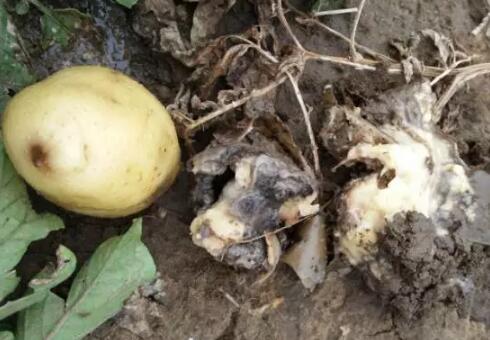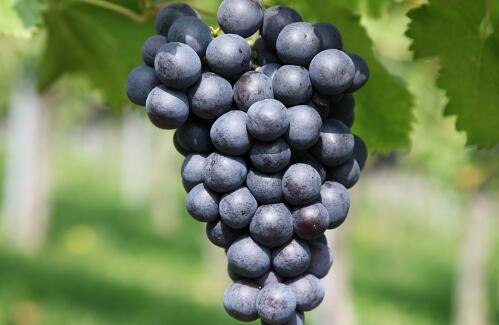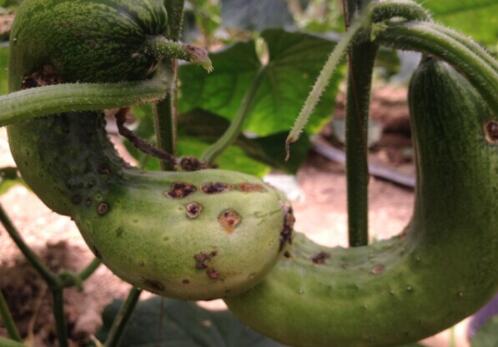What are the symptoms of tobacco, potato, cabbage and geranium black shank disease? What kind of medicine should I take?
Black shank is a bacterial disease. The pathogen can overwinter on plant residues in the soil or on diseased potatoes during storage, but it cannot stay in the soil for too long. It occurs in tobacco, potatoes, kale, cabbage, geranium and other crops. What are the symptoms of black shank disease? What kind of medicine should I take?

Black shank of potato
Black shank of potato is a bacterial disease that infects vascular tissue, which can occur in the whole growth cycle of potato. Warm and humid is conducive to the invasion of the pathogen, especially in the years with more Rain Water, the potato is more seriously damaged by black shank in low-lying areas.
Symptom expression
Seed potato: infected seed potato rot into a clumpy shape, do not sprout, or just germinated rotten in the soil, can not emerge.
Seedlings: infected seedlings generally show symptoms of plant height 15~18cm, plant dwarf, Internode shortening, or leaf curl, chlorosis and yellowing, or shank blackening, wilting and death. The three main vascular bundles were browned when the stem was cut across.
Potato pieces in the field: the infected potato pieces begin at the navel and radiate to the medulla, the diseased part is dark brown, the vascular bundles are also dark brown, and the flesh is not separated by hand pressing. when the humidity is high, the potato pieces become dark brown, rotten and stink, different from bacterial wilt.
Ways and laws of transmission
Seed potato transmission: seed potato carries bacteria, and the soil generally does not carry bacteria. Cutting knife infection is the main way of disease transmission when cutting potatoes. The pathogen first spread through cutting potato pieces, causing more kinds of potato disease, and then entered the plant through vascular bundles or pith, causing aboveground disease.
Field transmission: field bacteria can be transmitted through irrigation water, Rain Water or insects, invade through the wound to cause the disease, and the bacteria on the diseased plant in the later stage are transmitted from the aboveground stem to the new tuber through the stolon.
Storage transmission: during the storage period, germs infected healthy potatoes through contact with healthy potatoes through wounds or lenticels.
Morphological characteristics
Potato black shank is a bacterial disease, the pathogen belongs to Eucella, short rod-shaped, blunt round at both ends, 4-5 flagella, no spores, negative Gram staining reaction. The colony was grayish white and round on Agar medium. The pathogen could grow well in the range of 10-38 ℃, and the optimum value was 25-27 ℃. The pathogen lost its vitality when it was higher than 45 ℃.
Prevention and cure method
(1) selecting disease-resistant varieties.
(2) selecting disease-free seed potato to establish disease-free seed field.
(3) cut the potato with a cutting knife and sterilize it with alcohol or potassium permanganate in time, mix the seeds with rice or Cailong after cutting, and sow the seeds immediately after drying.
(4) sowing early at the right time, paying attention to drainage, reducing soil moisture, increasing soil temperature and promoting early emergence of seedlings.
(5) seed potatoes should be selected strictly before entering the cellar, and the management should be strengthened after entering the cellar. The pit temperature should be controlled at 1-4 ℃ to prevent excessive temperature and humidity.
(6) Pesticide control:
After emergence, 100 ml leaf spray was used for prevention, 300 ml for drip irrigation and 500 ml for sprinkler irrigation. Drip irrigation plus Renong 200g / mu and sprinkler irrigation 300g / mu in the middle and later stage of the disease.
Tobacco black shank disease
Symptom
During the disease of seedlings, black spots first occurred in the roots and stems near the ground, and the disease extended up and down, extending to all stems, leaves and main roots. The base of the diseased stem is slightly hanged, which is easy to cause quenching. In high humidity and rainy conditions, all the diseased seedlings rotted, white woolly mold was produced on the surface, and quickly spread to nearby seedlings, causing tobacco seedlings to rot and die. If the weather is dry, the diseased seedlings will dry up and turn dark brown. When the disease of seedlings is mild, the symptoms are not obvious. After tobacco seedlings are transplanted into the field, they encounter high temperature and humid environment, which is very easy to occur. Most of them begin to blacken at the rhizome intersection near the ground, and expand upward, often as high as 0.6 square feet, so it is known as black shank disease. Sometimes the disease blackens in the middle of the stem, which makes the tobacco plant die; sometimes the stem does not show disease spot and wither and die, and when the diseased plant is pulled up, the main root and branch root turn black and rot. Although the disease has a variety of symptoms, but the common characteristic is that the leaves of the diseased plants are gradually yellow, drooping and wilting from bottom to top, and can recover after the night. After 4 days, all the leaves withered, and finally the whole plant withered. The diseased plant is easy to pull up because most of the fine roots rot. In addition to the blackening of the cortex, the pith also turned black-brown, dry and shrunken in the shape of a laminate, and there was sparse white mold between the slices. In case of rainy and humid weather, there is also white mildew on the surface of the diseased tissue.
Prevention and cure method
1. Select disease-resistant varieties
two。 To strengthen the cultivation management, we should develop spring tobacco and transplant early so as to avoid the rainy season in the stage of infection. Practice crop rotation for more than three years; ridge soil cultivation, ditch drainage, ensure that tobacco fields do not accumulate water, do not flow "water", after ridging, the surface water does not come into contact with the base of the stem, so as to reduce the chance of infection; apply net fertilizer to keep the running water from being polluted by germs, uprooted diseased plants and picked diseased leaves should be treated centrally.
3. Chemical control according to the black shank pathogen with zoospore activity in the topsoil layer for re-infection, mainly invade the base of the stem, and after transplanting and before budding for the infection stage, chemical control, generally can receive more than 60% of the control effect. This is particularly necessary for some varieties with high quality and poor disease resistance. Diexong can be used, the dosage is 72 taels per mu, mix well with dry and fine soil, apply the soil once before sealing the nest and raising the ridge, sprinkle it around the tobacco plant, and restore the soil immediately, so as to avoid the failure of the light.
Black shank of cabbage
Most of them occur in high temperature, high humidity areas and seasons, which can be damaged in both seedling stage and adult stage, and cause plant death in serious cases. The disease not only harms cabbage, but also Chinese cabbage, rape, cauliflower, turnip, radish, kale, kale and celery.
Symptom
At seedling stage, light brown disease spots appeared on cotyledons, true leaves and young stems, the disease spots were round or oval, black spots were scattered on them, and the disease spots were slightly sunken on the young stems, and the seriously diseased seedlings withered quickly. The leaf disease spot in the adult stage is the same as that in the seedling stage, and there are purple-black stripes on the lateral root of the main root, which makes the root rot or fall down from the diseased stem.
Prevention and cure method
Seed treatment: soak the seeds in 50 ℃ warm water for 20 minutes. Seed dressing: seed dressing with 50% thiram wettable powder, the chemical weight is 0.4% of the seed weight. Soil treatment: 40% Fumishuang wettable powder or 40% pentachloronitrobenzene powder, 8 grams per square meter, 30 kilograms and 40 kilograms of fine dry soil, sprinkled on the bed when sowing. Crop rotation: the seriously affected fields should be changed in time or rotate with non-cruciferous vegetables, and it is better to rotate with field crops with an interval of more than 3 years. Chemical control: spray at the initial stage of the disease, spray 75% chlorothalonil wettable powder 600 times, or 40% polysulfide suspension 600 times, or 60% Duofu wettable powder 600 times, once every 8 to 10 days, twice in a row.
Black shank disease of geranium
Symptom
The disease occurred on both cuttings and adult plants, and the damage of cuttings was more serious. It began to rot from the base of the stem, developed upward, and caused death. After the onset of the disease, the adult plant turned black and expanded upward, and the leaves fell off, so that the whole plant withered and died.
Pathogen
Gorgeous Pythium, belonging to the subphylum flagellum. The hyphae are well developed, branched, without septum, and show white cotton floc shape when the growth is exuberant. The sporangia are filamentous, round or subrounded, producing zoospores and causing infection.
Prevention and cure method
1. When cutting, the branches on the healthy plants should be cut and cut in the seedbed free of pathogens.
2. When transplanting, it is necessary to change a new lot or change the basin soil to prevent the spread of diseases. If necessary, 1000-1500 times of the liquid of 70% dimethazone wettable powder can be poured on the soil surface.
Black shank disease of broccoli
[symptoms] also known as root rot, black root disease, etc., can be damaged at seedling stage and adult stage. Grayish-white irregular disease spots can appear in the infected cotyledons, true leaves or young stems at the seedling stage, and the base of the stem spreads to the roots to form black-purple stripes, and if the stem base ulcers are serious, the diseased plants are easy to break and dry up; the infected leaves of adult plants produce irregular to polygonal gray-white disease spots with many small black spots, that is, the conidium of the pathogen; pedicel, seed pod infection is similar to that on the stem. During the storage period, the diseased leaf bulbs were dried and rotted, the diseased stems were cut open, and the vascular bundles at the diseased roots became black.
Time: 2019-04-09 Click:
- Prev

Woody vine grape got gray mildew, downy mildew, powdery mildew what medicine?
Although the use of greenhouse and rain shelter can reduce the incidence of diseases to a certain extent, the disease will still occur if the environmental humidity is too high. If you are not careful, you will be infected with gray mildew, downy mildew, white rot, black pox, white rot and powdery mildew.
- Next

Common fruits and vegetables cucumber, banana, pear, citrus scab how to prevent and cure? What kind of medicine should I take?
Scab is a quarantine disease, which not only harms cucumber, but also harms zucchini, melon, pumpkin, banana, pear, citrus and so on. Then how to prevent and cure scab? What kind of medicine should I take? How to prevent and cure cucumber, banana, pear and citrus scab? Cucumber: (1) selecting disease-resistant varieties
Related
- Fuxing push coffee new agricultural production and marketing class: lack of small-scale processing plants
- Jujube rice field leisure farm deep ploughing Yilan for five years to create a space for organic food and play
- Nongyu Farm-A trial of organic papaya for brave women with advanced technology
- Four points for attention in the prevention and control of diseases and insect pests of edible fungi
- How to add nutrient solution to Edible Fungi
- Is there any good way to control edible fungus mites?
- Open Inoculation Technology of Edible Fungi
- Is there any clever way to use fertilizer for edible fungus in winter?
- What agents are used to kill the pathogens of edible fungi in the mushroom shed?
- Rapid drying of Edible Fungi

